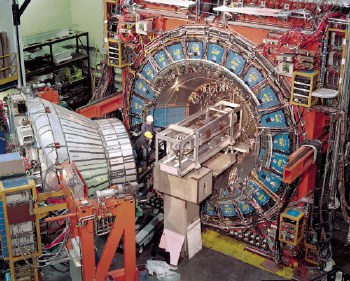Physicists from the Collider Detector (CDF) collaboration at Fermilab near Chicago have discovered two new particles, called sigma-b baryons. The particles are the heaviest baryons ever discovered and weigh about 5.8 GeV, or around six times more than the proton. One sigma-b comprises two “up” quarks and one “bottom” quark, while the other contains two “down” quarks and a “bottom” quark. The discovery provides further insights into the “strong” force that binds quarks together.

Baryons are particles containing three “quarks”, which are fundamental building blocks of matter. There are six different types, or “flavours”, of quark: up, down, strange, charm, bottom and top (u, d, s, c, b and t). Up and down quarks are the lightest and can be found in protons and neutrons.
The strange, charm, bottom and top quarks are heavier and are not found in ordinary matter. However, they can be created fleetingly in high-energy collisions at particle accelerators or in interactions between cosmic rays and atoms in the atmosphere. Scientists also believe these particles were present in the very early universe, just moments after the Big Bang
The CDF work was done using Fermilab’s Tevatron collider. Currently the world’s most powerful particle accelerator, it collides together protons and antiprotons moving at close to the speed of light. Out of the billions of collisions produced each second over the last five years, the CDF researchers identified 103 sigma-b particles containing a u-u-b configuration of quarks and 134 sigma-b particles containing a d-d-b configuration. The particles are extremely short-lived and decay within a tiny fraction of a second.
The sigma-b particles are the first baryons to be discovered that contain a bottom quark and are in an excited spin state. “These particles are like rare jewels that we mined out of our data,” says Jacobo Konigsberg of the University of Florida and a spokesperson for the CDF collaboration. “Piece by piece, we are developing a better picture of how matter is built out of quarks and learning more about the subatomic forces that hold quarks together and tear them apart.”
According to Konigsberg, the two distinct sigma-b particles were produced in two different spin combinations, which represent a ground state and an excited state. Their discovery provides further confirmation of quark theory.
Meanwhile, two new “xi” baryons containing “charm” and “strange” quarks have been discovered on the other side of the world by the BELLE collaboration at Japan’s KEK Laboratory (Phys. Rev. Lett. 97 162001).



